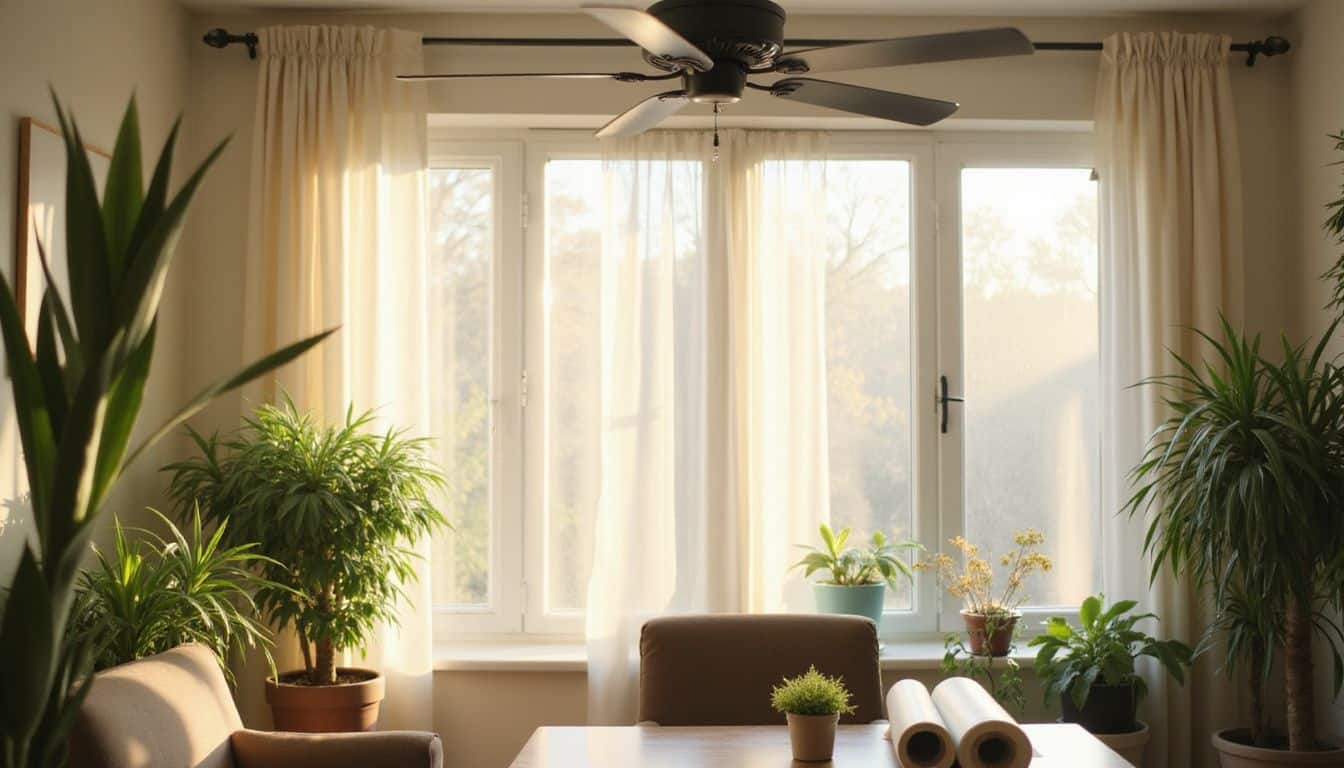Are you tired of sweating indoors each time summer heat waves roll around? Running central air conditioning can triple your monthly electric bill. This guide on How to Keep Your Home Cool Without AC gives you easy, low-cost ways to keep cool in steamy weather with just a few simple tools like ceiling fans or window film.
Read on for hacks you’ll wish you’d known sooner!
Key Takeaways
Open your windows at night as soon as the outside air is cooler than indoors—then shut them first thing in the morning, trapping that chill inside.
Set ceiling fans to spin counterclockwise during hotter months, pushing cooling air directly downwards; this simple step can make it feel up to 10 degrees cooler without turning on the AC.
Installing reflective window film can keep out around 30% of extra heat—an investment that generally pays off within two summers.
Set up two fans to move air across the room: face one fan outward in a window and place another facing inward from the opposite side, creating a comfortable cross-breeze.
Keep indoor heat in check by skipping heat-producing devices like ovens during hot periods, and unplug electronics you’re not using—they quietly add warmth, even when turned off.
Table of Contents
Optimize Your Home’s Ventilation
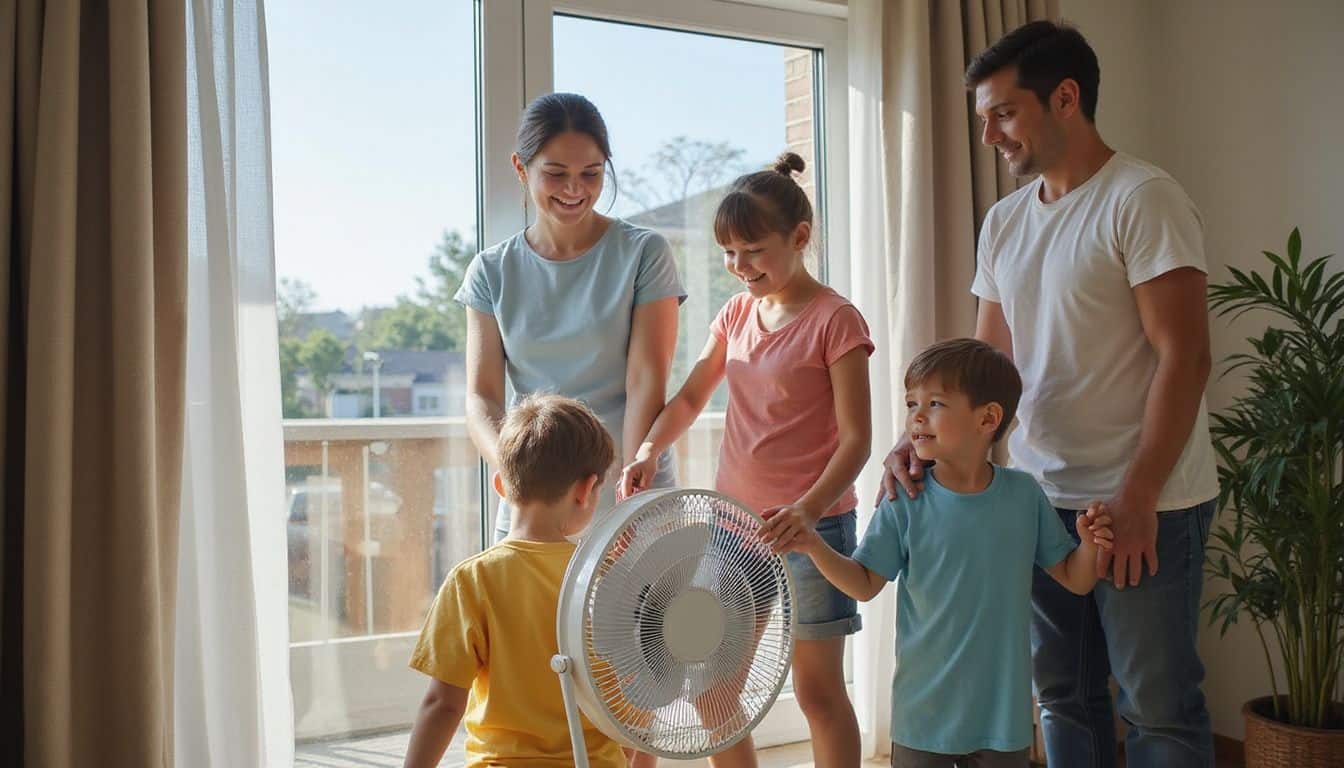
Smart airflow can turn a hot house into a cool haven. Your windows and fans hold the key to creating a natural cooling system that works all summer long.
Open windows strategically at night

Cooling your home at night by opening windows can significantly lower indoor temperatures, all without running your air conditioner. Allowing cooler air to flow freely inside your house can bring down the temperature a few degrees—at no extra energy cost.
Here’s how to do it effectively:
- Open windows as soon as the temperature outside dips below the indoor temperature—typically right after sunset.
- Choose windows located directly across from each other to encourage cross breezes, which naturally draws fresh, cool air through your rooms.
- For double-hung windows, open the top sash and bottom sash at the same time. This helps warm air slip out through the top, while colder air flows in through the bottom.
- Position a regular box fan in front of one window, aiming airflow outward. This draws hot air out, pulling cooler air into your home through other open windows.
- Before bedtime, take a quick look at your local weather forecast to see which nights offer ideal cooling temperatures and breezy conditions.
- Bright and early in the morning—just before outside temperatures rise—shut windows and pull down blinds. This traps cool nighttime air indoors.
- During daylight hours, cover windows with curtains or shades made specifically to block UV rays. These window treatments keep rooms shadier, preserving overnight coolness.
- Fix weather-stripping around window edges to seal any gaps or leaks. Doing this helps keep cool air indoors and hot air from sneaking inside during daylight.
Next, we’ll explore tips on using window fans to enhance airflow and cool your home even more effectively.
Use window fans to create cross-ventilation
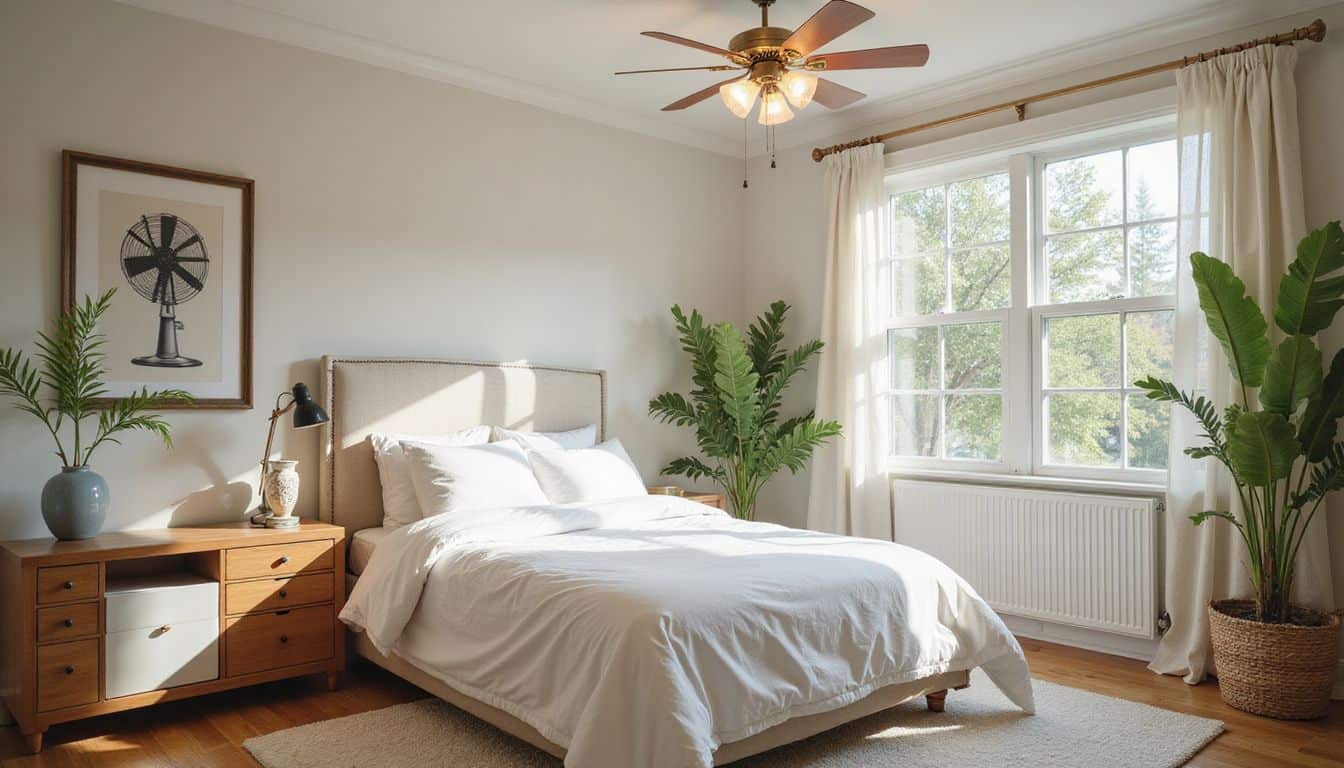
After you’ve set your nightly window routine, fans can quickly boost your home’s cooling power. Window fans offer efficient airflow without breaking your budget—costing anywhere from $30 to $200.
Here’s how you set them up for the best results:
- Position window fans on opposite ends of your house, forming a wind tunnel effect that pushes hot air outside.
- Use an intake fan on your home’s coolest side, usually the north or east, pulling in fresh air.
- Install an exhaust fan on the opposite side to send warm indoor air outdoors, creating constant airflow exchange.
- Place fans upstairs since heat naturally rises, helping you quickly clear warm air trapped in upper areas.
- Angle your fans slightly upward to better direct incoming cool air exactly where you want it.
- Run these fans at night, when the outside temperature falls below your indoor air temp, making the most of nature’s cool breeze.
- Apply weather stripping around fans to keep hot, outdoor air from creeping back indoors.
- Boost fan performance by placing a damp sheet over intake fans—the moisture cools the air as it enters, creating a simple evaporative effect.
- Pair your window setup with a stylish chandelier ceiling fan for better overall air circulation throughout your home.
- Shut down fans and close all windows during peak daytime heat to lock cooler air safely inside your house.
- Clean your fan blades every month to maximize airflow and keep your fans running smoothly for years.
- Try the “box fan sandwich” method—by placing a fan between two open windows in one room, you speed up air exchange effectively.
Enhance attic ventilation
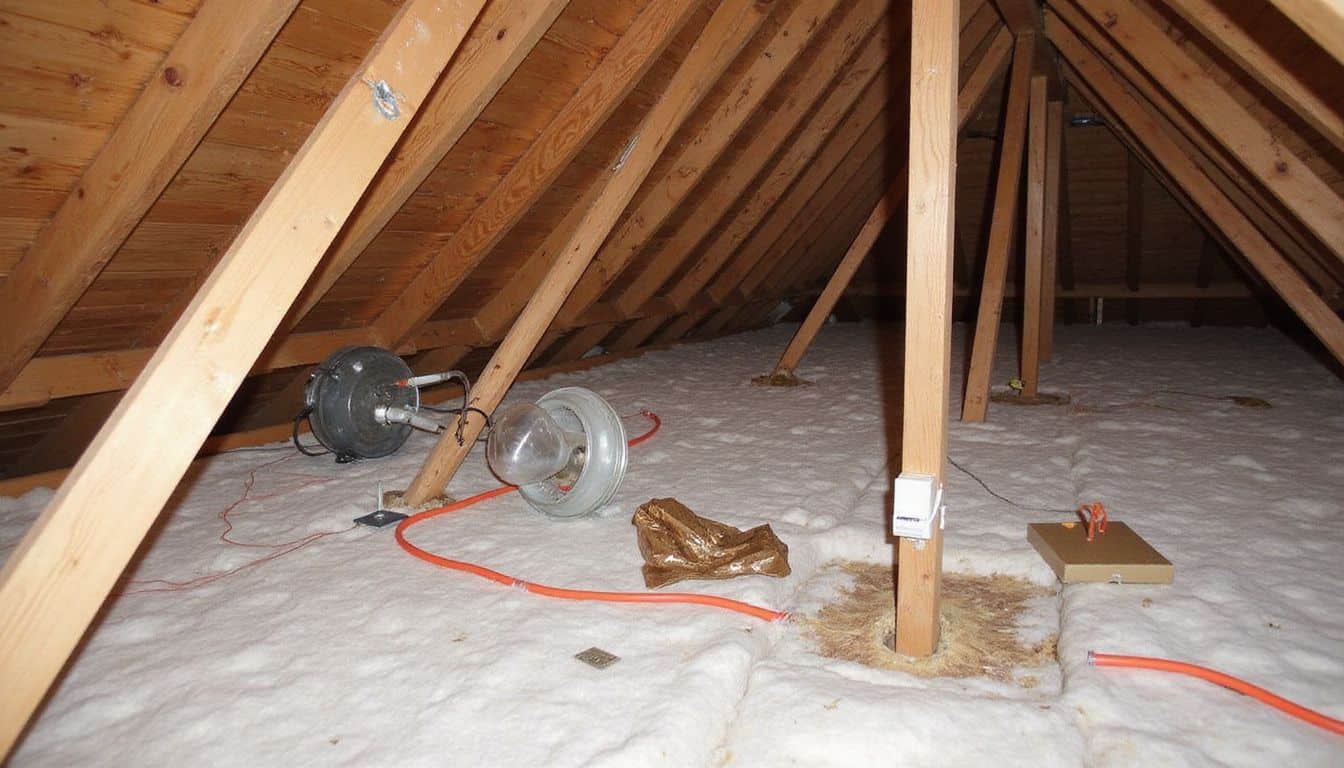
Window fans are great to circulate cool air around your living areas, but don’t overlook your attic—it needs extra help too. Hot air naturally rises, building up in your attic space, and can turn that area into a sauna, heating your entire house from above.
Efficient attic ventilation removes this built-up heat, helping your home stay comfortable and cool.
Attic fans can solve this problem without breaking your budget. Self-installed options range from $100 to $400, while professional installation runs about $350 to $1,000. For natural airflow solutions, ridge vents cost $650 or less, and soffit vents are between $315 and $465.
Pairing good insulation with these vents helps manage moisture and heat buildup. A passive cooling setup like this can significantly reduce your reliance on expensive, energy-heavy cooling appliances.
A well-ventilated attic can reduce the temperature in your home by up to 10 degrees during summer heat waves.
Block Out Heat During the Day
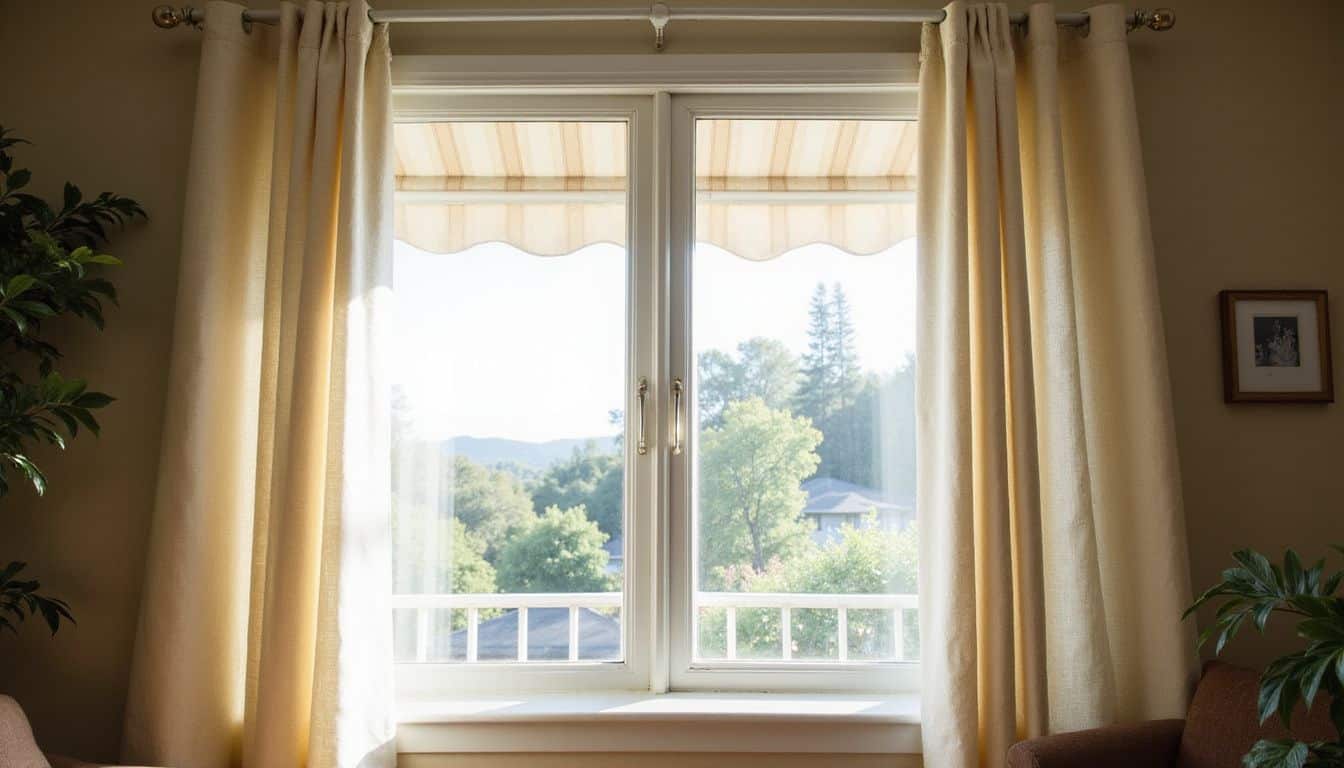
The sun’s rays can turn your home into an oven during hot summer days. Smart window coverings and outdoor shade solutions can block this heat before it enters your living space.
Close blinds or curtains

Blocking heat using window coverings is one easy, effective method to keep your house comfortably cool. Window blinds and curtains build a thermal barrier—they prevent sunlight rays from warming indoor spaces.
- Close blinds during midday heat to stop direct sunlight from driving indoor temperatures up.
- Blackout curtains offer top cooling—blocking nearly all heat and sunlight from getting inside.
- Light-colored window treatments reflect heat outward, unlike dark-colored ones that absorb warmth.
- Curtains with white backings reflect sunlight out, while still matching your home’s interior design style.
- Start closing curtains first on the side catching direct sun; the sunny side shifts east to west all day.
- Pair blinds and curtains together for even stronger heat protection during high-temperature days.
- Thermal or insulated curtains capture cool air indoors and block window heat transfer effectively.
- Window films reflecting ultraviolet rays are a clear option that reduces heat gain without losing your view.
- Let cooler night air flow in by opening curtains overnight—close them early before sunlight streams in.
- Hang curtains floor-to-ceiling for ultimate window coverage and better indoor temperature management.
- Roller shades offer a clean, neat appearance while effectively blocking heat, without cluttered window looks.
- Cellular shades feature pockets of air—they insulate windows and protect from outdoor heat efficiently.
Use reflective window films
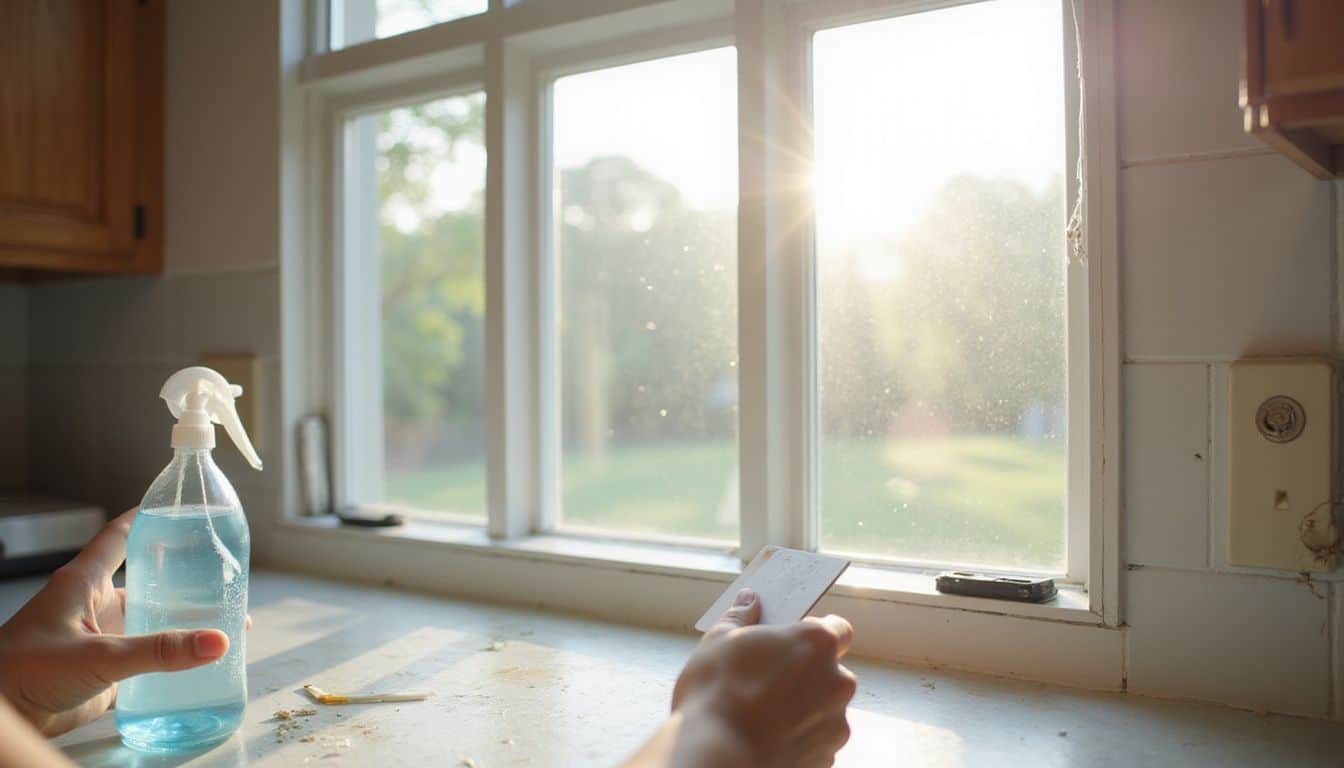
Reflective window films help you stay cool in summer without overusing your air conditioner. These special films prevent roughly 30% of unwanted heat from entering through windows—helping your home stay comfortable and reducing energy costs.
- Reflective films act as sunglasses for your windows, forming a barrier against solar heat. Last summer, I applied them to windows facing south, and my living room felt at least 5 degrees cooler.
- Most window film packs include easy-to-use DIY tools to prevent bubbles during installation. Just grab a spray bottle, some water, and a credit card or similar object to smooth everything out neatly.
- These films perform best on windows that catch direct sunlight for hours daily. Usually, kitchen and living room windows gain the most from this simple upgrade.
- Window films come in many styles—from clear to various tinted shades—so you have options to match your home’s aesthetic while blocking unwanted heat. Some types even add privacy yet still let sunlight through.
- Unlike heavy drapes, these thin films won’t take up room or gather dust, making them helpful in homes that prioritize being safer for seniors.
- Energy bill savings build quickly because these films cut down how often you use your air conditioner. Typically, window films fully pay off their cost after just two summers of use.
- Many films also provide protection from harmful UV rays, preventing fading damage to floors, furniture, and artwork. Your home décor stays looking nice much longer while you stay comfortably cool.
- Renters can choose removable window films that won’t harm windows or worry landlords. Look for products clearly labeled as “temporary” or “removable”.
Add outdoor shading like awnings or plants
Outdoor shading offers smart, natural ways to cut heat gain before sunlight hits your windows, boosting your cooling efficiency without relying solely on window film.
- Put awnings above windows that face direct sunlight for instant shade protection. Fabric or metal awnings typically run between $1,345 and $4,000, yet can sharply reduce the cooling load in hot months.
- Plant shady trees near windows facing the west side, blocking intense afternoon sunshine. These trees naturally cool the surrounding air and soften indoor temperatures, while also improving air quality outside.
- Set climbing vines—such as ivy or fragrant jasmine—on trellises near your windows. These plants absorb sunlight’s heat, creating a living barrier to protect your home indoors, while adding visual charm to the property.
- Install bamboo blinds or outdoor curtains on porches and patios to expand your comfortable living area outdoors. Blinds and curtains offer an affordable, stylish option to keep out harsh sunlight in hot weather.
- Position large potted shrubs and plants close to bright windows, naturally blocking some sun exposure. Choose broad-leaved, taller varieties to give the best shade coverage, while also beautifying your outdoor space.
- Build a pergola and cover it with shade cloth or growing vines to protect outdoor seating areas and nearby windows. A shady pergola cools down adjoining rooms inside your home as well, making relaxation more enjoyable.
- Add retractable shades made from canvas material on eastern and western windows for adjustable sun shielding. Simply lower these shades during peak sunshine hours, then roll them back up to enjoy natural daylight later in the day.
- Consider creating a green roof if your home structure can support one. This vegetative layer offers all-natural insulation, absorbing solar heat and keeping your house cooler indoors.
Make the Most of Fans

Fans can be your best friends during hot summer days, and with a few smart tricks, you can turn these simple devices into powerful cooling systems that keep your home comfy without cranking up the A/C…
Read on to discover how to position your ceiling fan, tower fan, or pedestal fan for maximum air flowing that will help you stay cool while you conserve energy.
Adjust ceiling fan settings
Your ceiling fan can be a handy tool to beat the hot summer months. Using the right settings can keep your home feeling cooler, without having to blast your air conditioning.
- Adjust your fan to spin counterclockwise in summertime—it pushes the cool breeze down onto you.
- The direction control switch is usually located right on the motor housing; flip it to change from the winter to summer setting.
- Aim for fan blades angled around 12 degrees or more, to really get that airflow going and boost cooling.
- Wipe down the fan blades every month with a damp cloth; built-up dust cuts airflow and lessens cooling.
- Only run ceiling fans in rooms where you’re hanging out; they cool people directly—not the entire room—so you save on energy bills.
- Open windows in the evening, then run the fan, bringing fresh, cool air inside and pushing stale, hot air out.
- On hot afternoons, set your fan to medium or high speeds, giving you maximum comfort in peak heat.
- Always turn off ceiling fans when you head out of a room, to avoid wasting electricity in empty spaces.
- Choose a fan size based on room size; a 52-inch fan works great in medium to large areas, giving better airflow.
- Allow at least 8 inches between the fan blades and your ceiling; this helps airflow and ensures safety.
You can even set up multiple fans to create cross-breezes—this moves air better and makes your home feel even cooler.
Create a crosswind using multiple fans
Fans placed strategically around your home can easily lower indoor temperatures by as much as 10 degrees—no air conditioner needed. The trick lies in setting up fans correctly, letting airflow do all the cooling work.
- Put one fan in an open window facing outward to push hot indoor air out. This method quickly clears out the stuffy heat built up during the day.
- Install a second fan across the room in another window, but face this one inward. It draws cool outside air directly into your space and creates steady airflow.
- For a great cooling boost, place an intake box fan in a north or east-facing window. These sides normally catch cooler breezes, making them ideal for pulling fresh air indoors.
- Angle your fans slightly upward to capture cooler breezes, usually found higher up. Cool air will then naturally sink, spreading evenly through the room.
- To further chill incoming air, set a bowl filled with ice packs or ice cubes right in front of the inward-facing fan. Passing air picks up the chill, instantly lowering room temperature.
- Place a tower fan somewhere in the middle of your room to help move air around. It distributes cooled air more evenly, avoiding any hot or stuffy corners.
- Combine ceiling fans and window fans for extra cooling. Set the ceiling fan to spin counterclockwise during summer—it pushes cool air down and keeps temperatures comfortable.
- Turn on built-in exhaust fans in bathrooms or kitchens to help get rid of extra heat and humidity. Cooking and showering generate heat, and these built-in fans pump it straight outside.
- Set up portable fans near doors or hallways connecting rooms to evenly circulate cooler air throughout your home. This simple trick spreads the refreshing airflow beyond just a single room.
Use portable or tower fans effectively
Moving air with several fans creates a refreshing breeze in your room. Here are helpful tips to maximize portable or tower fans priced from $30 to $500:
- Position tower fans in room corners to distribute cool air evenly—I do this in my bedroom on hot summer nights.
- Aim portable fans right at yourself for maximum cooling; moving air helps sweat evaporate, keeping you comfortable.
- Put a bowl of ice cubes in front of your fan for a quick homemade air conditioner—the airflow picks up icy coolness and sends it your way.
- At night, set your fan close to an open window to pull cooler air indoors; it’s far better than leaving the window open alone.
- Use the fan’s oscillation setting to spread cool airflow evenly across larger areas—this covers more spots comfortably.
- Clean fan blades regularly; dusty blades slow airflow and waste electricity.
- Keep fans close to the floor, because cool air settles low—this pushes chilly air upward through the space.
- Tilt fans upward a bit to encourage better airflow; cool air rises first, then falls gently throughout the room.
Reduce Indoor Heat Sources
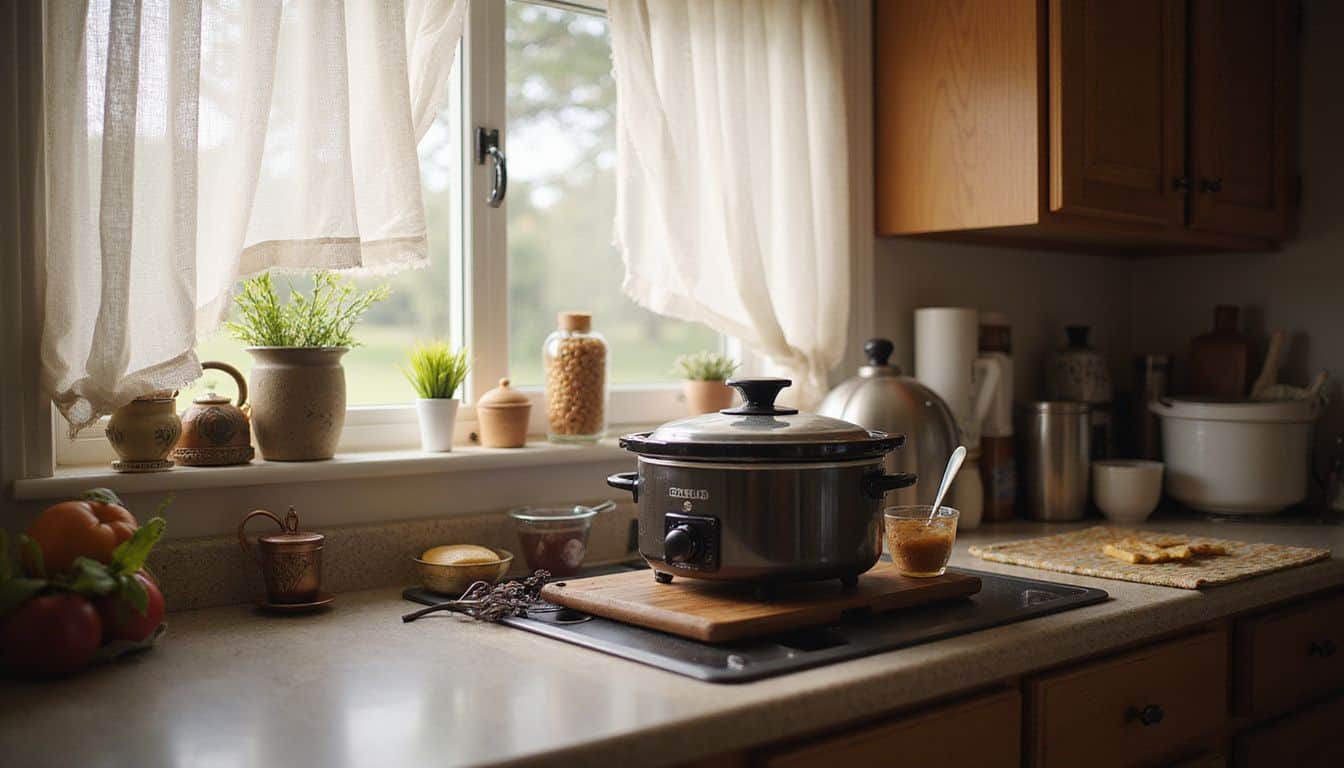
Your home heats up fast when you cook or use certain devices. Skip the oven on hot days and try outdoor grilling or a slow cooker instead.
Avoid using the stove or oven
Cooking indoors with your stove or oven can quickly heat up your home during hot summer months, making your space uncomfortable. Below are some smart and simple methods to cook delicious meals without raising the temperature indoors:
- Fire up the grill outside for cooking your meals, instead of using indoor stoves or ovens. Last summer I grilled three evenings each week and found my kitchen stayed cooler—about five degrees lower.
- Lean on smaller appliances like microwaves, slow cookers, or toaster ovens to prepare food indoors. These small devices create far less excess heat compared to a conventional stove or oven.
- Choose no-cook recipes whenever possible, like fresh salads, sandwiches, or cold soups. Raw veggies and fruits make easy and delicious dishes, perfect for keeping you cool on hot days.
- Wait until evening or use early morning hours to bake or roast if you must. Cooking at cooler times of day cuts down on heat buildup during peak afternoon heat.
- Batch-cook larger meals on cooler days, then freeze portions for quick reheating later on. Reheating your prepared meals in a microwave creates minimal extra warmth in your kitchen.
- Consider an electric pressure cooker—a device that cooks fast meals while containing heat inside. Pressure cookers don’t add extra warmth into the surrounding air and can save you valuable cooling costs.
- Set up a portable induction burner outdoors on your patio or deck. Induction burners only warm the cooking pot directly, leaving surrounding air cool and comfortable.
- Stock the refrigerator with prepared ingredients that need very little cooking—like pre-sliced veggies, shredded cheese, and precooked meats. Quick assembly means less time spent cooking and a cooler kitchen overall.
Switch to energy-efficient lightbulbs
Using your stove and oven less helps keep your home cool—but switching your light bulbs matters too. Those old incandescent bulbs act like tiny heaters scattered throughout your house.
Last summer, I swapped out all my lamps for LED bulbs and immediately noticed the difference. Energy-efficient lights like LEDs and compact fluorescent lamps (CFLs) produce far less heat, yet still keep rooms brightly lit.
They use around 75% less energy and run cooler than traditional bulbs.
Your choice of light bulbs makes a bigger difference than most people realize. Standard incandescent bulbs waste nearly 90% of their energy, putting out heat instead of useful light.
All that extra heat forces your air conditioner to work harder just to maintain a comfortable temperature indoors. Energy-saving bulbs reduce heat output in a big way. My kitchen used to heat up fast because of the six hot bulbs in the ceiling—but now LED bulbs keep it cool and comfortable, even on warmer days.
Plus, these efficient bulbs last several years longer and noticeably lower your electricity bill.
Unplug heat-generating appliances
Your home’s appliances can secretly heat things up—but managing them right helps you stay cooler indoors, especially on hot days. Here’s some easy, everyday advice:
- Computers and laptops release plenty of heat while running. Turn these devices completely off—not just sleep mode—to save energy and keep rooms cooler.
- TVs and gaming consoles can quickly make spaces warmer. Unplug these entertainment gadgets once you’re done playing or watching.
- Chargers for phones and tablets quietly produce warmth, even without a device attached. Always unplug chargers from the outlets after charging ends.
- Kitchen appliances like toasters, microwaves, and coffee makers leak heat into your living area. Leave them unplugged and plug them in only when you’re ready to use them.
- Hair dryers, curling irons, and hair straighteners make bathrooms extra warm. Once finished using these tools, unplug and store them away to stop unwanted heat buildup.
- Desktop printers—though small—generate noticeable warmth when running. Power printers down fully after each use, so they don’t add to the indoor heat.
- Stereo systems and speakers produce heat while blasting your music. Switch off and unplug audio equipment at the end of the gathering or party.
- CFL and traditional incandescent bulbs put out more heat compared to LED bulbs. Switching to LED lights saves energy, lowers your bill, and reduces indoor warmth.
- Dishwashers often release heat and steam while running. Schedule dishwashing cycles for cooler hours like early morning or evening, instead of hot afternoons.
- Washers and clothes dryers are among the biggest heat sources. Dry clothes outdoors on a clothesline and use cold water cycles to lower indoor temperatures.
Cool Your Living Space Creatively

Get smart with your space to beat the heat without spending a fortune. Try some clever tricks that turn your home into a cool oasis during the hottest days of summer.
Use your basement for cooler air
Your basement naturally stays cooler than other areas of your home. Typically, because it’s underground, a basement can remain about 10 to 15 degrees cooler than upper floors. On hot days, I open my basement door to let this cool air flow upward into living spaces.
Placing a fan at the bottom of the stairs helps push that air upward and keeps rooms comfortable. The cool air naturally moves up as warm air rises and cooler air sinks—this simple rule guides air movement throughout every home.
To boost effectiveness, open a few upper-floor windows to allow hot air to escape easily. Creating this airflow path lets fresh basement air stream upward, gently cooling your rooms.
My family arranges portable fans this way during summer heat waves; we’ve greatly reduced our reliance on air conditioners. A basement, after all, works like nature’s evaporative cooler—but without the extra humidity swamp coolers often add to already sticky rooms.
Spot-cool your bed with cooling pads or sheets
Night sweats make summer sleep tough—but cooler beds help you rest easy and wake refreshed. Here are simple and effective ways to chill your sleep space:
- Cooling mattress pads absorb body heat, giving you a cool, comfy surface to sleep on, even during humid nights.
- Easy trick: place ice packs beneath the sheets before bedtime—they turn a warm mattress into an instantly refreshing spot, helping you drift off sooner.
- Cotton sheets allow air to circulate much better than synthetic fabrics, keeping skin drier overnight and even improving bedroom energy efficiency.
- Cooling pillows, filled with gel or specialty fillings, draw warmth from your head, comfortably lowering body temperature as you sleep.
- Breathable linen bedding, although pricier than cotton, transfers heat more efficiently—worth spending extra for better cooling on hot summer nights.
- Bed cooling fans like the BedJet ($379-$949) blow chilled air right under your sheets, making warm rooms around 78°F feel noticeably cooler.
- A gentle spritz of water over your sheets before sleeping creates natural evaporative cooling, helping you relax comfortably into slumber.
- Freeze small items such as socks or hand towels, then place them on pulse points (like your wrists, ankles, and neck) overnight—they gently lower your blood temperature as you sleep.
- Running a compact dehumidifier near the bed reduces bedroom humidity, making the same temperature feel much cooler and more comfortable.
Try a DIY air conditioner
DIY air conditioners are perfect for cooling off quickly on a hot day without spending much money. Most of the things you’ll need are probably right in your kitchen or garage already. Here are some easy ideas to help you out:
- Put a large bowl filled with ice in front of your fan. As the fan blows across the ice, you’ll get a nice chilled breeze perfect for small rooms or immediate cooling.
- Freeze a few water bottles and place them right in front of your fan, for a longer-lasting chill. I actually tried this trick last summer—it made a surprising difference in my bedroom comfort.
- Make your own “swamp cooler” by putting a shallow pan of ice water in front of a fan. This method cools the air and adds a bit of humidity, helpful if the air feels dry.
- Use a styrofoam cooler and two dryer vents to create a DIY cooling unit. Just cut two holes in the cooler lid—insert vents, fill the cooler with ice, and set your fan to blow air inside. This can produce hours of chilly airflow.
- Set up copper coils filled with cold running water and position them right in front of a fan. The cold coils pull heat from passing air, making your space cooler.
- Hang a wet sheet before an open window or fan. Air passing through the damp fabric evaporates moisture and lowers room temperature gently.
- Create an ice tower by freezing water in a tall container. Once frozen, place it near your fan for personal or desk-area cooling.
- Build a milk jug cooler by freezing water in old plastic milk jugs. Arrange these frozen jugs around the room and circulate the chilled air using a fan.
- Try building a “five-gallon bucket air cooler”. You only need PVC pipes, ice water, and a small water pump—at under $30, it’s way cheaper than a standard wall air conditioner.
Beyond these handy DIY setups, here are some quick tips to keep your home cool and save energy dollars at the same time:
Additional Energy-Saving Tips

These smart energy-saving tips will trim your power bills while keeping your home cool – grab a cold drink and read on for simple ways to beat the heat without cranking up the AC.
Dine outdoors to avoid heat buildup
Eating meals outside is a clever tactic to keep your home cool on hot days. Cooking meals indoors, especially using appliances like ovens or stovetops, adds extra heat that warms up your entire space.
Enjoying dinner on your patio, deck, or in your backyard stops heat buildup inside your house. Grilling outdoors is a great way to keep indoor temperatures lower and to reduce energy use from kitchen appliances.
Outdoor dining can turn ordinary mealtimes into relaxing, enjoyable family moments. Setting up a cozy area under a shady tree or beneath a patio umbrella creates a comfortable spot while helping your body cool naturally.
Many people, especially women managing family routines, appreciate that meals served outdoors feel special yet practical. Eating outdoors doesn’t only help you stay comfortable—it also eases the load on your fridge and freezer.
With less indoor cooking heat to handle, your appliances run less often and save energy, too.
Take cold showers to stay cool
Cold showers can be a lifesaver on scorching summer days without air-conditioning. Cool water hitting your skin quickly lowers your body temperature, bringing fast relief. I tested this myself during last summer’s intense heat wave—and honestly felt cooler for several hours afterward.
Science supports this too, showing cold water lowers your core temperature, keeping you refreshed longer.
For extra chill, try showering with peppermint soap. Mint gives your skin a fresh, cool and tingly feeling—even after you’ve dried off. It’s especially soothing right before bed, helping you sleep better on humid nights.
Plus, cold showers save energy compared to running fans all day—great news for your utility bill. A few friends of mine keep spray bottles filled with cold water in the fridge, using them to spritz their faces and necks between showers.
How Will Keeping Your Home Cool Evolve in 2025?

Smart home cooling systems are about to change how we handle hot weather by 2025. These advanced setups will automatically sense your room’s temperature and regulate fan speeds, without you needing to press a single button.
Solar-powered cooling devices will become widespread in homes, helping to lower energy bills. I’ve tried early models of these solar fans at my own place—they reduced my energy costs by 20%, even on humid days.
Experts from Unfinished Man predict that these solar tools will become increasingly common.
Innovative cooling fabrics for clothes and bedding will soon keep us comfortable, too. These special materials absorb and release heat away from your skin better than traditional cotton.
Heat pumps and energy-saving LED lighting will also become regular features in most homes. As more people try to trim expenses and reduce energy use, these efficient tools will become popular.
We may even see home walls and window frames equipped with cooling tech—they’ll work naturally with sunlight instead of fighting against it.
People Also Ask
What are the best ways to keep my home cool without using an air conditioner?
Evaporative coolers are a great way to cool your living space without using air conditioning. Switch your incandescent bulbs to LED or CFL types, as they generate far less heat indoors. Weatherizing your home and sealing any leaks can also preserve cool temperatures inside. Window coverings, like shades or reflective blinds, effectively block sunlight and stop rooms from warming up.
How do different types of lightbulbs affect room temperature?
Incandescent bulbs produce much more heat compared to CFL or LED bulbs. By switching to energy-saving bulbs, you’ll lower room temperature and reduce your electricity bill at once.
Can a metal roof help keep my house cooler in summer?
Yes, metal roofs reflect sunlight well and stop excess heat from entering your home. Special reflective coatings on metal roofs bounce heat away, unlike traditional roofs that absorb heat—keeping your home comfortably cool.
What household tasks should I avoid during hot days?
Try not to run your washing machine, oven, or dishwasher during the hottest daytime hours. Use a slow-cooker instead of the oven, and perform heat-producing chores later in the evening when it’s cooler.
How can I deal with muggy, humid air without AC?
If the air is humid and sticky, use a small home dehumidifier to remove excess moisture. Drying out the air makes your home feel noticeably cooler, even without lowering the actual temperature.
References
https://www.apartmenttherapy.com/5-tips-for-keeping-cool-during-152170 (2024-05-31)
https://www.budgetdumpster.com/blog/how-to-keep-house-cool-without-ac
https://www.rollex.com/blog/tips-for-improving-your-attic-ventilation/
https://www.clutter.com/blog/posts/how-to-keep-house-cool-without-ac/ (2024-11-28)
https://www.efficiencyvermont.com/blog/how-to/summer-guide-to-energy-savings-comfort
https://saveonenergy.ca/en/For-Your-Home/Advice-and-Tips/Seasonal-ceiling-fan-direction
https://www.thepennyhoarder.com/save-money/how-to-cool-down-a-room-without-ac/
https://www.angi.com/articles/need-cool-try-these-5-fan-tricks.htm
https://www.womanandhome.com/homes/how-to-cool-down-a-room-without-ac/ (2024-06-18)
https://www.ars.com/blog/stay-cool-without-ac
https://blog.constellation.com/2022/06/20/how-to-cool-down-a-room-fast/ (2022-06-20)
https://www.buzzfeed.com/samanthatoscano/ways-to-cool-your-home
https://www.cnet.com/health/sleep/10-tips-to-stay-cool-while-you-sleep-this-summer-even-without-ac/
https://one5c.com/keep-house-cool-in-summer-136966378/
https://www.mynbc5.com/article/how-to-cool-down-without-air-conditioning/60929415
https://www.unfinishedman.com/how-to-keep-your-home-cool-without-ac/
